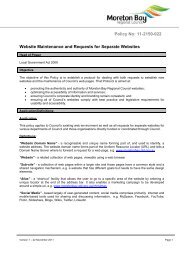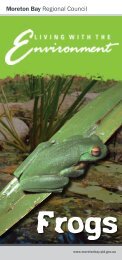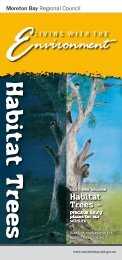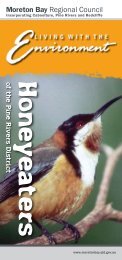Caboolture Region Water Quality Study - Moreton Bay Regional ...
Caboolture Region Water Quality Study - Moreton Bay Regional ...
Caboolture Region Water Quality Study - Moreton Bay Regional ...
You also want an ePaper? Increase the reach of your titles
YUMPU automatically turns print PDFs into web optimized ePapers that Google loves.
<strong>Caboolture</strong> River Catchment<br />
condition has remained fairly stable over recent years, although concentrations of oxidised nitrogen<br />
have improved at the more downstream sites (WAR4,5,6).<br />
The only site (WAR-2) to have an overall good water quality rating has also been found to have fish<br />
communities that are classed as being in reference condition (Langdon, 2001). Other sites further<br />
downstream, despite their poor water quality rating, had fish populations at moderate to sub-reference<br />
conditions. The size of the riparian vegetation was good throughout Wararba Creek, although the<br />
integrity was moderate to poor (Appendix G, ANA, 1998).<br />
Two of the six sites monitored on Wararba Creek received good ratings for faecal coliforms, whereas<br />
the other four received moderate ratings. Sorces of faecal contamination may include wild animals<br />
and domestic stock.<br />
5.1.4 Sheepstation Creek<br />
<strong>Water</strong> quality at all sites in Sheepstation Creek was rated as being in moderate or poor condition, with<br />
the more upstream sites being of poorer condition than the downstream sites. All sites had poor<br />
dissolved oxygen levels, the upstream sites had high levels of turbidity and total phosphorous, and all<br />
sites were rated as being in moderate condition for faecal coliforms. Analysis of changes in water<br />
quality assessments over recent years indicated a reduction in concentrations of oxidised nitrogen and<br />
total nitrogen at most sites, and a reduction in turbidity at downstream sites.<br />
Concentrations of toxicants at two sites in Sheepstation Creek were good (below trigger levels) for all<br />
toxicants, although lead concentrations were moderate at one site on one date, which may have<br />
originated from roadways given this site is in an urbanised area.<br />
Riparian vegetation, aquatic vegetation, reach environs and aquatic habitat are in poor or moderate<br />
condition at downstream sites, whereas these attributes are in moderate to good condition further<br />
upstream (SoR, 2001). Stream bed and bank stability have been classed as stable throughout<br />
Sheepstation Creek, and fish communities at two sites in the middle reaches of the creek have been<br />
classified as being degraded to severely degraded (SoR, 2001).<br />
5.1.5 Lagoon Creek<br />
<strong>Water</strong> quality at seven of the eight sites in Lagoon Creek was rated as poor; the remaining site<br />
received a moderate rating. All sites had low concentrations of dissolved oxygen, with lowest levels<br />
being recorded at the most downstream site. However, this site is a freshwater wetland and low<br />
dissolved oxygen and pH could be expected due to the accumulation of organic matter and limited<br />
water flow. Most sites also had high levels of turbidity and high concentrations of ammonia. Many sites<br />
showed an improvement in concentrations of oxidised nitrogen and total nitrogen in recent years, and<br />
some sites showed improvements in turbidity (Table 5). The regressions trend analysis also showed<br />
that other sites have reduced in condition with regard to turbidity, and that some sites have<br />
deteriorated with regard to dissolved oxygen and pH (Table 31).<br />
Most biological and physical indicators such as fish, riparian vegetation, reach environs, bank stability<br />
and bed and bar stability all increased in quality from downstream to upstream sites (Appendix, F, G;<br />
SoR, 2001; Langdon, 2001). However, aquatic habitat was moderate at downstream sites and<br />
decreased to poor at the more upstream sites; aquatic vegetation was poor throughout the creek<br />
(SoR, 2001).<br />
Sites LC6 and LC7 were had moderate concentrations of total petroleum hydrocarbons in the<br />
sediments (Table 6), which may be a consequence of their proximity to highways and main roads of<br />
the shire. Lead concentrations were moderate at one site on one occasion, and concentrations of all<br />
other toxicants were good at all other sites (Table 6). Most sites received good condition ratings for<br />
faecal coliforms, although sites LAG-5 and 6 received only moderate ratings.<br />
20


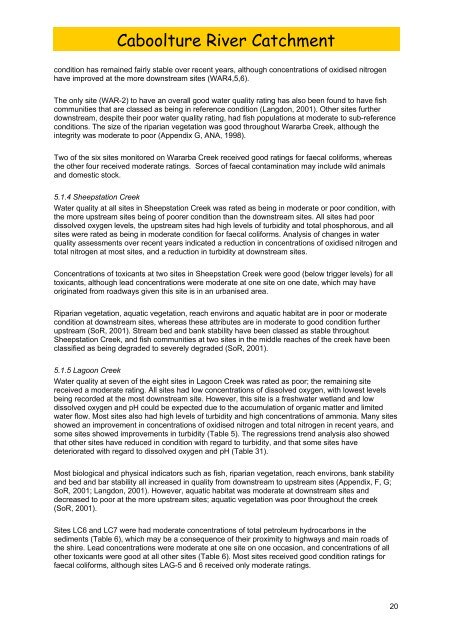
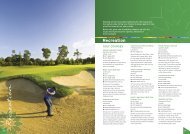

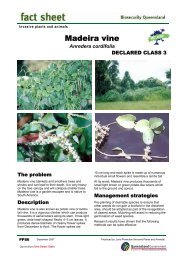
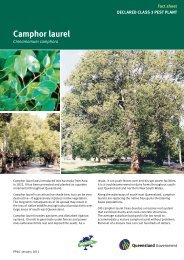


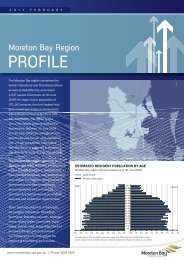
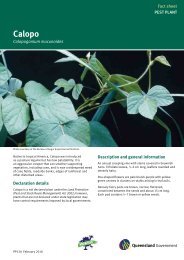

![Kumbartcho Brochure [PDF 540KB] - Moreton Bay Regional Council](https://img.yumpu.com/47220970/1/190x101/kumbartcho-brochure-pdf-540kb-moreton-bay-regional-council.jpg?quality=85)
